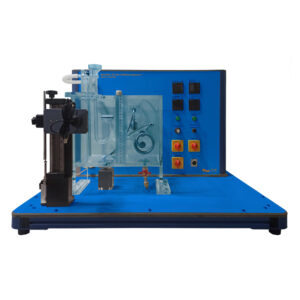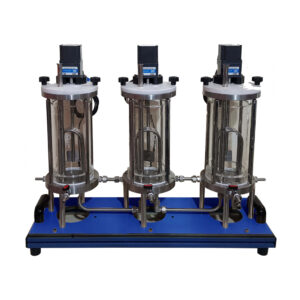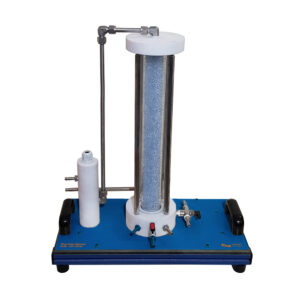The operation of stirred tank reactors can be either continuous or intermittent. Discontinuously operated stirred tank reactors are typically employed when the reaction rates are extremely slow or the product amounts to be produced are minimal. Continuous stirred tank reactors provide for the dependable manufacture of substantial amounts of consistent-quality output. This equipment series that enables research with various reactor types includes the CRE-3305-01. It is possible to study the operation and behavior of a stirred tank reactor in both continuous and discontinuous operation using the supply unit CRE-3305. The supply unit CRE-3305 is equipped with a heating water circuit, all required connections, pumps, reactant tanks, and a product tank.
The CRE-3305-01 is attached to the supply unit and secured in place by two pins. The reactor may be quickly and easily connected to the supply unit using quick-release connections. Two pumps on the supply unit continuously feed the reactants into the reactor. By ensuring a homogenous mixture, a stirrer extends the amount of time that the reactants are in direct contact. The reactants react to create the product.
Through an overflow, the combination of product and unconverted reactants is transferred into a tank of the supply unit. The overflow might vary in height. As a result, the reactor volume can be changed. By varying the speed of the pumps on the supply unit, the retention duration of the reactants in the reactor can be changed. The stirred tank reactor’s chambered bottom acts as a heat exchanger to analyses how temperature affects the process. By measuring the conductivity, the conversion in the stirred tank reactor is identified. The CRE-3305 comes with a conductivity/temperature combination sensor. On the supply unit, conductivity and temperature are digitally shown.
Technical Data
Stirred tank reactor
- DN 100
- Height: 250mm
- Material: boro 3.3 glass
- Reactor capacity approx. 1950mL
Stirrer
- Speed: 300min-1
- Drive: variable speed
- Brushless geared motor
Required: Service Unit for Chemical Rectors CRE-3305.




